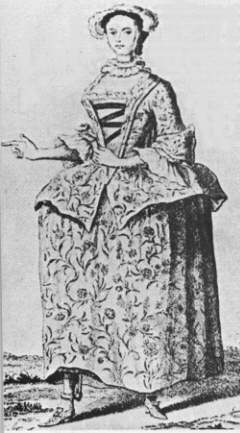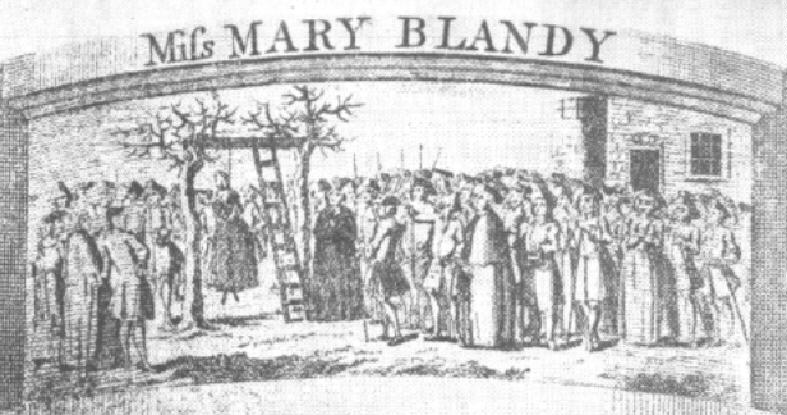|
Mary Blandy – patricide 1752. |
 Mary Blandy was 31
when she was hanged in 1752 for the murder of her father by poisoning. She was
unusual in the annals of female criminals of the time - she was middle class and
well educated. Her father, Francis Blandy, was a prosperous lawyer and the Town
Clerk of Henley on
Mary Blandy was 31
when she was hanged in 1752 for the murder of her father by poisoning. She was
unusual in the annals of female criminals of the time - she was middle class and
well educated. Her father, Francis Blandy, was a prosperous lawyer and the Town
Clerk of Henley on
Francis had unwisely advertised a dowry of £10,000 - a huge sum for those days,
for the man who married Mary. This attracted plenty of suitors, all of whom
being promptly rejected except one, the Honourable
Captain William Henry Cranstoun, who was initially
acceptable. Cranstoun was the son of a Scottish
nobleman and therefore seen as a suitable match for Mary. By all accounts he
was not a physically attractive person but seems to have been able to take Mary
in completely. All went well to begin with but then problems arose when it was discovered
that Cranstoun was in fact still married, having wed
one Anne Murray in 1744 in Scotland, although he had been living in the Blandy
household for a year. Mary's father became very unhappy about Cranstoun and began to see him for what he was. To get over
Francis' hostility, Cranstoun persuaded Mary to give
her father powders which he described as an ancient "love philtre"
and which he assured her would make Francis like him.
He knew
what the powders contained but presumably didn't mind letting his girlfriend
murder her father to get the £10,000 dowry. Ironically Francis Blandy's estate came only to around £4,000. Under the law
at the time, this would have automatically passed to him if they married.
Mary
seemed to be totally taken in by Cranstoun and
administered these powders, which were in fact arsenic, in her father's tea and
gruel. He became progressively more ill. The servants had also become ill from
eating some of the left over food although they all recovered. None of this
seemed to register with Mary - that the powders might be the cause of the
problem.
When her father was seriously ill and obviously near death, Mary sent for the
local doctor who advised her that she could be held responsible for poisoning
him so she quickly burned Cranstoun's love letters
and disposed of the remaining powders. Susan(nah) Gunnell,
the housemaid, had the presence of mind to rescue some of the powder from the
fire when Mary tried to destroy the evidence and take it to a chemist for
analysis who found that it was arsenic. Arsenic is a cumulative poison and only
kills when the levels have built up in the body.
Francis
realised he was dying and asked to see Mary, telling her that he suspected he
was being poisoned by her. She begged for his forgiveness, which he indeed gave
her, despite the fact that she did not admit her crime to him. He finally
succumbed to the poison on
Trial.
She came to trial at Oxford Assizes on
She defended herself with the help of three counsel,
with what has been described as "intelligence and zeal" although her
case was hopeless. She made an impassioned speech for her own defence in which
she totally denied administering poison but did admit that she had put a powder
into her father's food - she claimed "which had been given me with another intent." The servants gave evidence against her
- telling the court that they had seen her administering the powders to her
father's food and drink and trying to destroy the evidence.
Not surprisingly at the end of the one day 13 hour trial, the jury swiftly
convicted her of murder and she received the mandatory death sentence. She was
then returned to
She was allowed nearly 6 weeks between sentence and execution and appeared
completely unmoved by her situation. The trial judge would have sent his
recommendation to the Secretary of State, and this would have been considered
by the King and Privy Council at a “Hanging Cabinet.” Few murderers were
reprieved, although it was not entirely unknown. Poisoners stood even less chance.
In June 1752, the Murder Act of 1751 came into force. It stipulated that all
persons convicted of murder were to be fed only on bread and water and hanged
within two days of sentence and that their body be
dissected afterwards. Fortunately for
Mary, she missed this new law and was able to be buried in a proper grave.
Mary was the main news story in the early part of 1752 and there were endless
stories about her in the press. She also
wrote a great deal in the condemned cell including "Miss Mary Blandy's Own Account of the Affair between her and Mr. Cranstoun" which was described by Hoarce
Bleakley as the "most famous apologia in
criminal literature." She
corresponded with various people, including another woman under sentence of
death, Elizabeth
Jeffries (who was convicted, with her lover John Swan, and hanged at Epping
Forest in
A middle class lady who visited Mary in prison was shocked to find that Mary
was sympathetic to this woman who she regarded as a common criminal who
deserved her fate. Mary was recorded as saying of her "I can't bear these
over virtuous women. I believe that if ever the devil picks a bone it is one of
theirs."
Execution.
There seems to be some difference of opinion as to the place of execution. According to some accounts, she was executed
in the Castle Yard at Oxford (a large open space) and in other accounts the
gallows was set up on a raised mound at the Westgate. Both are quite possible.
She was hanged on Monday the 6th of April 1752 from a gallows consisting of a
wooden beam placed between two trees. (see below). For
her execution, she chose “a black crape sack, with her arms and hands ty'd with black paduasoy
ribbons.” She behaved with bravery and
penitence to the end and was attended by the Reverend Swinton. She suffered in front of a relatively small
crowd to whom she protested her innocence before she was turned off.
Her last request to the officials was "for the sake of decency, gentlemen,
don't hang me high." She was naturally modest and concerned that the young
men in the crowd would look up her skirts if she was too high.
She was then made to climb a ladder draped in black cloth, whilst the hangman
climbed a ladder beside her. Mary was noosed and her hands were tied in front
to allow her to hold her prayer book. She covered her face with a large
handkerchief. Her legs were not tied together.
It had been agreed that when she had finished her prayers, she would drop the
book as signal to the hangman to turn the ladder over and "turn her
off" as the saying went. She passed
into unconsciousness very quickly and, as reported, "died
without a struggle" - presumably due to vagal or carotid reflex. She was taken down after half an hour but
there was no coffin for her so she had to be carried back to the castle by six
men. It is said that a blackbird perched
on the beam during the hanging, and that no blackbird has ever sung there
since.
She was buried in the early hours of the Tuesday morning in the chancel of
Henley Parish Church, between the graves of her father and mother. The church has since been restored and there is
now no trace of her grave. Her ghost is
said to haunt the Westgate and the Little Angel Inn.

A
woodcut of Mary’s execution.
Comment.
So what do we conclude from this sad case which has remained famous for almost
250 years? Mary was notably brave in the way she faced her death. She knew she
would die in public and would have expected that death by hanging would be slow
and painful even though in the event it seemed not to be. Her last words
("for the sake of decency, gentlemen, don't hang me high") became
instantly famous although they hardly seem those of someone who is terrified as
to what lays ahead - rather more those of someone concerned with preserving her
modesty than with her imminent death.
She
admitted her guilt, at least to herself and probably felt that death was a
proportional punishment for her crime. At that time, hanging was the punishment
for many crimes - all far less serious than hers - so there was no expectation
of a reprieve to a sentence of transportation.
She was completely alone in the world, she was an only child, her parents were
dead (her mother by natural causes) and abandoned by her lover.
Mary must have been totally devastated at the knowledge that the man who she
thought loved her had duped her into murdering her own father and then
immediately abandoned her to save his skin while allowing her to take the
punishment.
But how
could an educated and mature woman be so taken in? Sadly she was by no means
the first, nor will she be the last to murder for love. She must surely have
had her suspicions when everyone who ate the food to which she had added the
powders became violently ill and yet she brushed these aside in the hope that Cranstoun would marry her.
By the
standards of justice prevailing in 1752, Mary had a fair trial and a fair
sentence. Ironically, modern forensic science would have simply made it easier
to convict her. The only doubt as to her guilt is that of her intention - she
loved her father and I feel sure she neither meant nor wanted to kill him but
rather wanted to believe what Cranstoun had told her
even though she had clear evidence that it was wrong. At one time, arsenic was
used as a tonic and this may account for why her father seemed actually better
the first time she gave it to him.